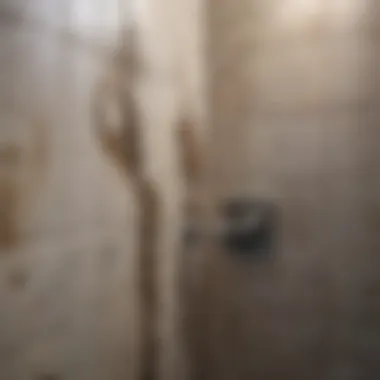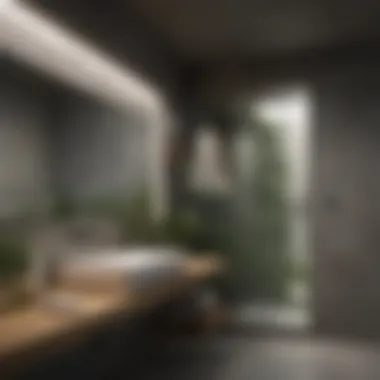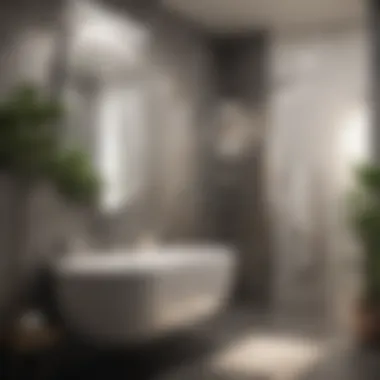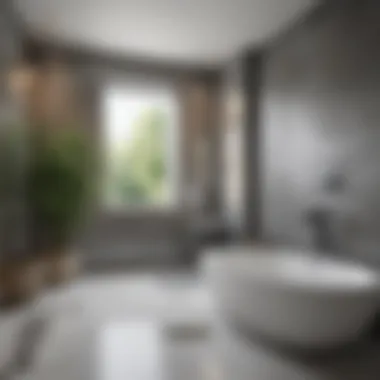Effective Ways to Clean Mold and Mildew in Your Bathroom


Intro
Mold and mildew can be persistent problems in bathrooms, creating not only an unsightly appearance but also potential health issues. Understanding the causes of these fungi is crucial for effective cleaning and prevention. This article serves as a comprehensive guide, detailing methods that homeowners and design enthusiasts can employ to keep their bathrooms clean and healthy.
Mold thrives in environments that are damp and poorly ventilated. Bathrooms, often closed off and humid, provide the perfect conditions for mold spores to settle and grow. Regular maintenance, proper cleaning techniques, and knowledge of suitable products are paramount in combating this issue.
In the following sections, we will explore cleaning methods, the importance of a good ventilation system, and preventive measures. By the end of this guide, readers will be equipped with practical insights tailored to modern interior spaces.
Intro
Mold and mildew in bathrooms pose significant challenges for homeowners. This article focuses on understanding and addressing these issues. Bathrooms, by their nature, are often humid environments. This makes them prime locations for mold growth. Ignoring this can lead to more severe problems, including health risks and structural damage.
By understanding the dynamics of mold and mildew, readers can take proactive measures. This guide outlines the importance of both cleaning methods and preventative strategies. The right knowledge empowers individuals to maintain a clean space, promoting health and safety.
"Consistent upkeep of bathrooms is key to preventing mold infestations."
A clean and mold-free bathroom not only enhances the aesthetic appeal of the home, it can also prevent potential health issues. Mold spores can trigger allergies and respiratory issues. Therefore, addressing mold problems is crucial for the well-being of all occupants.
This guide aims to equip homeowners with comprehensive knowledge. From identifying common locations for mold to learning effective cleaning techniques, each section of the article is designed to provide practical insights. Understanding these elements is the first step to fostering a healthier living environment.
Identifying Mold and Mildew
Identifying mold and mildew is a critical step in maintaining a healthy bathroom environment. Mold and mildew thrive in damp, warm places, making bathrooms a prime location for their growth. Recognizing the signs of these fungi early can prevent more significant issues such as structural damage or health problems. Moreover, proper identification aids in choosing the right cleaning methods and tools to effectively combat the problem.
Common Locations in the Bathroom
Mold and mildew can often be found in specific areas within the bathroom. Here are the typical locations to check:
- Shower and Bath Areas: These spaces tend to have high moisture due to the steam from hot water.
- Around Sinks: Drips and splashes create ideal conditions for the growth of mold.
- Toilet Base: Leaks can lead to moisture accumulation, forming a breeding ground for mildew.
- Ceiling Corners: Poor ventilation may cause condensation, leading to mold forming where it’s least expected.
- Caulking and Grout: These materials can trap moisture, allowing mold to settle.
Focusing on these areas will help you identify potential mold problems swiftly, minimizing the risk of them spreading.
Signs of Infestation
Detecting mold and mildew infestation involves more than just visually spotting it. Here are important signs to consider:
- Visible Growth: This might appear as patches of green, black, or white, indicating the presence of mold.
- Musty Odor: A persistent damp smell could suggest hidden mold behind walls or underneath fixtures.
- Water Stains: Dark water stains on walls or ceilings can indicate moisture retention, hinting at mold growth.
- Condensation Issues: Increased condensation on windows or walls is a sign of high humidity levels, which can lead to mold.
- Respiratory Problems: If household members experience allergy-like symptoms or respiratory issues when in the bathroom, mold could be a culprit.
Recognizing these signs allows homeowners to take action promptly, maintaining a safe and healthy bathroom atmosphere. Quick identification facilitates effective remediating steps, thereby protecting both the property and the residents.
Causes of Mold and Mildew Growth
Understanding the underlying causes of mold and mildew growth in bathrooms is essential. These factors not only contribute to unsightly stains and unpleasant smells but may also pose health risks. Recognizing these causes enables homeowners to take targeted action to eliminate existing mold and prevent future infestations. In this section, we will explore three primary causes that influence the proliferation of mold and mildew in bathrooms: humidity levels and ventilation, water damage and leaks, and poor lighting conditions.
Humidity Levels and Ventilation
High humidity is a significant contributor to mold growth. Bathrooms typically generate moisture from showers, baths, and sinks. When humidity levels exceed 60%, mold spores can thrive. It is important to maintain proper ventilation to control moisture. Installing exhaust fans that vent outside is a practical solution. These fans help reduce humidity by expelling moisture-laden air.
- Key Considerations:


- Run exhaust fans during and after showers.
- Open windows when feasible to allow fresh air circulation.
- Consider using a dehumidifier for persistent humidity problems.
A well-ventilated bathroom will have better air circulation, leading to lower humidity and reduced chances for mold growth.
Water Damage and Leaks
Water damage from leaks is another prevalent cause of mold and mildew. Leaks may originate from plumbing fixtures, showerheads, or even tiled surfaces. If undetected, water can seep into walls and floors, creating a damp environment ideal for mold growth. Regularly inspecting for leaks is vital.
- Actions to Take:
- Check plumbing for any signs of leakage or dampness.
- Repair any damaged tiles or grout immediately.
- Monitor areas near water sources, such as sinks and toilets.
Addressing water damage promptly can prevent extensive mold issues, potentially saving on more costly repairs in the long run.
Poor Lighting Conditions
Poor lighting conditions can also contribute to mold and mildew problems. Mold thrives in dark and damp environments. Areas in the bathroom that do not receive adequate natural or artificial light become prime sites for mold growth. Improving lighting can help keep mold at bay.
- Improvement Suggestions:
- Install bright, energy-efficient lighting fixtures.
- Choose light colors for bathroom walls and decor to reflect light better.
- Use task lighting around mirrors and in dark corners.
By addressing these three causes of mold and mildew growth, homeowners can significantly reduce the likelihood of encountering mold problems in their bathrooms. Taking proactive measures is crucial for maintaining a healthy and pleasant environment.
Cleaning Techniques for Mold and Mildew
Natural Cleaning Solutions
Vinegar
Vinegar is a common household item known for its ability to kill mold spores. Its acetic acid content helps to break down mold structures efficiently. As an effective natural cleaner, vinegar is non-toxic and safe for most surfaces, making it a beneficial choice for cleaning bathrooms. However, its strong smell can be off-putting. It works best on non-porous surfaces and may require several applications for tougher infestations.
Baking Soda
Baking soda is another excellent option when tackling mold and mildew. It acts as a mild abrasive, making it suitable for scrubbing away growth without damaging surfaces. Moreover, it is an effective deodorizer. It can be used to create a paste when mixed with water, allowing for focused cleaning. The downside is that it may require more elbow grease and may not be as effective on porous materials like grout.
Tea Tree Oil
Tea tree oil exhibits natural antifungal and antibacterial properties, making it a powerful mold fighter. This essential oil is effective in small concentrations and is preferred by many for its pleasant scent compared to vinegar. It does not require rinsing after application, reducing the cleanup process. However, its cost can be a disadvantage, especially for larger cleaning tasks.
Commercial Cleaning Products
Mold Removal Sprays
Mold removal sprays offer convenience and immediate results for homeowners. These products often contain strong biocides that eliminate mold effectively. Many sprays are formulated to prevent future growth, ensuring longer-lasting protection. An important consideration is to use these products in well-ventilated areas due to potential harmful fumes. They sometimes include chemicals that can cause damage to sensitive materials.
Bleach Solutions
Bleach is often seen as the go-to solution for disinfecting and removing mold. Its high effectiveness against a variety of mold types makes it popular. Bleach is fast-acting and can sanitize surfaces effectively. Nonetheless, it can discolor surfaces, especially porous ones, and it does not penetrate material that is deeply infested, which could lead to mold returning after cleaning.
Cleaning Tools and Equipment


Scrub Brushes
Scrub brushes are an essential tool for removing mold and mildew. With stiff bristles, they provide the necessary friction to lift away growths from surfaces. They are versatile and can be used on various materials, from tiles to sinks. The only downside is their requirement for physical effort and sometimes require several cleanings to fully remove stubborn mold.
Steam Cleaners
Steam cleaners offer a chemical-free alternative for cleaning. They use high-temperature steam to kill mold spores effectively without harsh chemicals. This method also sanitizes the surface, making it a valuable tool for thorough cleaning. However, it can be costly and may not effectively remove mold from deep-seated areas.
Protective Gear
When cleaning mold, using protective gear is crucial. Gloves and masks can protect skin and lungs from exposure to mold spores and harsh chemicals. A good quality mask will filter out small particles, which is especially important during intensive cleaning sessions. While it adds to the cleaning process, safety should always remain a priority.
Step-by-Step Cleaning Process
Preparation and Safety Measures
Before diving into the cleaning process, it is vital to prepare adequately and take necessary safety measures. Mold spores can be harmful, particularly to individuals with respiratory issues or allergies. Therefore, wearing protective gear is not merely an option, but a necessity. This includes gloves, goggles, and, ideally, a mask to avoid inhaling spores.
In addition to personal protection, it's advisable to ventilate the area. Open windows and doors to allow fresh air circulation. If possible, utilize a fan to keep the air flowing. Having a protective step, such as placing plastic sheets on nearby surfaces, can also prevent accidental contamination. Following these cardinal safety precautions sets the stage for an effective cleaning experience.
Initial Assessment of Affected Areas
Conducting a thorough initial assessment is essential to understand the extent of the mold infestation. Start by examining typical areas prone to moisture, such as corners of the shower, behind the toilet, and around sinks. Look for discoloration, stains, or fuzzy growths, which are common indicators of mold or mildew.
Documenting which areas are affected can be beneficial. This focus helps you allocate cleaning resources effectively. Note the size of the affected areas as well. This will guide the amount of cleaning solution you will need, as well as determine the requisite effort and time for a full clean.
Application of Cleaning Solutions
Once the assessment is complete, it's time for application of cleaning solutions. This step varies based on the chosen cleaning method—natural or commercial. Natural solutions like vinegar or baking soda are effective for smaller growths, while commercial products might be needed for larger infestations.
For instance, if using vinegar, spray it directly on the affected areas and let it sit for about an hour. This duration allows the solution to penetrate and break down the mold's structure. If a commercial mold removal spray is used, follow the manufacturer's instructions for optimal results. Apply the solutions generously to ensure thorough coverage.
Rinsing and Drying
After the application phase, rinsing is important to remove any residual cleaning solution as well as mold remnants. Use warm water and a clean cloth or sponge to wipe down the surfaces. Ensure all areas that were treated are rinsed well. Not doing this could result in residue building up, which might lead to further issues later.
Post-rinsing, drying the area is equally crucial. Mold thrives in moisture, so ensure the surfaces are properly dried. A good method is to use a fan or dehumidifier in the bathroom. Open windows again to allow for evaporative drying.
By following these steps systematically, one can effectively combat mold and mildew, ensuring the bathroom stays not only clean but also safe for its users. This structured process, combined with preventive measures, creates a mold-resistant environment in any home.
Preventative Measures
Preventing mold and mildew growth in the bathroom is critical for maintaining a safe and healthy environment. Mold and mildew not only negatively affect aesthetics but also pose health risks such as allergies and respiratory issues. The proactive approach is far more effective compared to remediation after an outbreak. This section focuses on essential preventative measures that every homeowner should consider to minimize the risk of mold development.
Improving Bathroom Ventilation
Proper ventilation is perhaps the most significant factor in preventing mold and mildew. Bathrooms are typically humid environments, and without adequate airflow, moisture accumulates, creating an ideal breeding ground for mold.
- Install Exhaust Fans: A powerful exhaust fan can remove excess humidity quickly. Ideally, it should be vented outside and run for at least 30 minutes after a shower or bath.
- Open Windows: Where practical, opening windows can create cross-ventilation, allowing moist air to escape.
- Use Dehumidifiers: In areas with high humidity, a dehumidifier can be beneficial. This device actively reduces moisture levels in the air.
Improving ventilation not only limits mold growth but also enhances overall air quality within your home.


Regular Maintenance Practices
Regular maintenance practices are essential in ensuring that your bathroom stays mold-free. Establishing routines can go a long way in minimizing mold risks.
- Clean Frequently: Regular cleaning cycles should include scrubbing showers, sinks, and toilet areas to remove potential mold spores.
- Monitor for Leaks: Regularly inspect pipes, faucets, and the toilet for any signs of leaks. Even small leaks can lead to damp areas that encourage mold growth.
- Seal Grout Lines: Over time, grout can wear down and allow moisture to penetrate, making it susceptible to mold. Sealing these lines can be an effective measure to keep them watertight.
These practices facilitate a cleaner environment and help catch potential issues before they escalate into larger problems.
Choosing Mold-Resistant Materials
Selecting the right materials during renovations or repairs can significantly impact mold prevention efforts. Investing in mold-resistant options is wise for long-term gains.
- Mold-Resistant Paint: Special paints come with ingredients that inhibit mold growth. These are particularly beneficial in walls surrounding showers.
- Use Moisture-Resistant Drywall: Also known as green board, it is designed to resist moisture and is ideal for humidity-prone areas.
- Opt for Vinyl Flooring: Unlike wood or carpet, vinyl flooring does not absorb moisture, making it easier to keep dry and clean.
Choosing materials wisely can add another layer of protection against mold and mildew and ultimately result in a healthier home.
Remember: A proactive mindset when it comes to preventing mold is always more effective and less costly than dealing with an outbreak.
When to Seek Professional Help
Addressing mold and mildew in the bathroom can be an arduous task. While many homeowners can handle minor infestations, there are instances when seeking professional help becomes essential. Understanding when to call in an expert can save time, money, and resources. This section elucidates the key aspects associated with knowing when professional intervention is necessary.
Assessing the Severity of the Problem
Assessing the severity of mold issues is crucial. Not all mold problems are the same. Homeowners should evaluate the extent of the problem before deciding on the cleaning approach.
Here are some important factors to consider when assessing the severity:
- Size of the Infestation: Small patches of mold can often be managed with DIY solutions. However, if the mold covers a large area, or if it appears behind walls or under flooring, it is a sign of a more serious issue.
- Type of Mold: Some mold types, like black mold (Stachybotrys chartarum), can pose serious health risks. Identifying the type may need professional help.
- Health Concerns: If anyone in the household experiences respiratory problems, allergies, or other health concerns that may be worsened by mold exposure, professional help should be sought promptly.
- Past Water Damage: If there has been prior water damage, such as a flooded bathroom, it is likely that mold has developed beyond visible areas, requiring a more thorough inspection and remediation.
Advantages of Professional Remediation Services
Engaging professional remediation services comes with distinct advantages. Professionals bring specialized knowledge, equipment, and techniques that vastly improve the chances of successful mold removal. Some benefits of hiring experts include:
- Thorough Inspection: Professionals can identify hidden mold and assess structural damage. This can include checking areas that are often overlooked by a typical homeowner.
- Effective Removal Techniques: Experts have access to powerful cleaning solutions and tools that are often not available in retail settings. Their methodologies provide a greater chance of completely eliminating mold.
- Prevent Future Growth: Before remediation, professionals will typically conduct assessments to understand the root causes of mold growth. They can suggest preventative measures to avoid recurring issues.
- Safety Considerations: Handling mold can be hazardous. Professional services adhere to safety protocols that protect both the individuals involved and the surrounding environment. This includes using appropriate protective gear and containment methods.
- Final Evaluation: Once the cleaning process is done, professionals can provide a final inspection to ensure that the area is free of mold and safe for occupancy.
Choosing to hire a professional can often mean the difference between a simple fix and a much larger problem later on.
In summary, knowing when to seek professional help for mold and mildew in the bathroom is critical. By assessing the issue accurately and recognizing the advantages of expert intervention, homeowners can ensure a healthier living environment.\n
Culmination
Mold and mildew in bathrooms is not trivial. Ignoring these issues can lead to more severe health problems and costly repairs. This article emphasized not only the significance of understanding mold and mildew, but also the necessity of prompt action. Taking a proactive approach is essential. The discussion on identifying mold and mildew, their causes, and how to clean them effectively serves as a valuable guide.
Recap of Key Points
- Understanding the nature of mold and mildew helps in recognizing their presence early.
- Moisture is the primary catalyst, hence improving ventilation and addressing leaks are vital preventive steps.
- Various cleaning techniques, both natural and commercial, can efficiently remove mold.
- Sometimes, professional remediation may be warranted for severe infestations.
Taking these factors into account leads to a healthier living space. Fostering a mold-free environment is not merely a task; it is an ongoing commitment. Regular assessments and adopting the right cleaning techniques can greatly minimize the chances of mold returning. In the end, safeguarding your bathroom ensures a safer home for all inhabitants.
Fostering a Mold-Free Environment
Dealing with mold and mildew is about more than just cleaning up after an incident. It involves consistent, everyday practices that prevent their growth in the first place. Regularly inspecting high-humidity areas like showers, sinks, and tubs can go a long way. Here are some strategies to implement:
- Ventilate: Always use exhaust fans or open windows to allow air circulation.
- Dry: Wipe down wet surfaces after use. Water left on tiles and grout can create the perfect breeding ground for mold.
- Regular Maintenance: Replace cracked tiles and caulking as needed. These small changes prevent moisture accumulation.
- Choose Fittings Wisely: Selecting materials that resist mildew or mold can help. This includes mold-resistant paints and sealants.
Adopting these practices establishes a protective barrier against mold. Thus, homeowners can maintain a clean and safe bathroom, reinforcing the structure and aesthetics of their homes.















